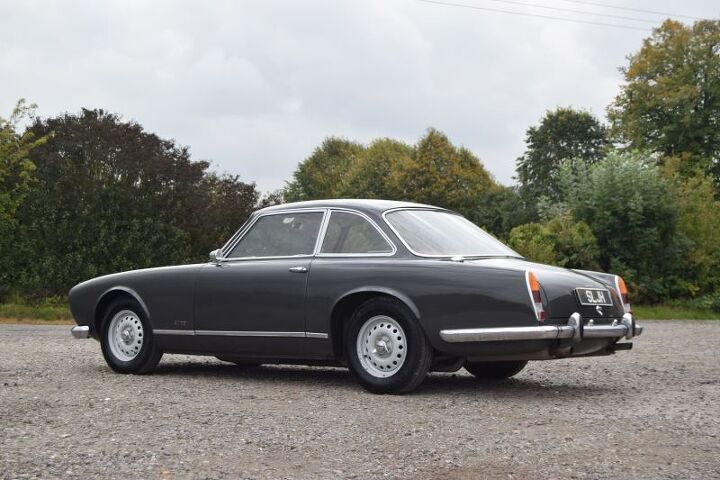Rare Rides: A Gordon-Keeble From 1965 – Turtles Love Them!

Our last Rare Ride was a convertible Cadillac by the name of Allanté. It mixed American power and engineering with a body designed in Italy. Today we take a look at something with the same sort of principles, but with the additional quirkiness of a British backstory.
And it’s much, much rarer than the Cadillac.
The shapely graphite coupe you see before you is the Gordon-Keeble. Conceived by John Gordon and Jim Keeble, the duo desired to create an exciting new sports coupe. They had a four-seat coupe in mind, with a space-frame chassis, top speed of 140 mph, and a cross-continental collaboration mindset. The two men ran with their idea and did some international mélange-making.
For the design, the pair turned to well-known design firm Bertone. The order landed on the desk of none other than 21-year-old Giorgetto Giugiaro. And not only is it a Giugiaro from before the ItalDesign era, but it is the first Giugiaro car design. This coupe matters.
The unique turtle badge of the marque has a quaint story behind it. During the first photo shoot for the new Gordon-Keeble, a turtle walked into the frame of the shot. A slow turtle and a fast coupe would make for a delicious bit of badge irony, the owners thought.
For the space under the sloping bonnet and behind the turtle, the duo contacted a company across the sea called General Motors. In 1960, Gordon and Keeble sent their completed prototype (which contained a Corvette 283 cubic inch V8) over to Detroit. Ed Cole at Chevrolet was rather impressed. He agreed to supply up to 1,000 Corvette 327 cubic inch V8 engines and accompanying transmissions for the production run of the Gordon-Keeble. This was the first official endorsement by GM for overseas shipment of components for a specialty car.
Like so many British shed corporations, however, trouble was already in the works for Gordon-Keeble. Suppliers needed for crafting the body were not easy to find, and adequate factory space not easy to come by. The design’s steel body panels were swapped for simpler fiberglass before production began, but it was near the end of 1963 and not a single car had been finished.
Factory space was finally found at an airfield, in a building formerly used to produce Spitfires for use in WWII. Production began in early 1964, but infighting between Gordon and the lead investor made for a rough time. There was simply no money, and a liquidation occurred after the company produced around 90 cars. In 1965, those new owners resumed production, but only managed to build a few more cars. Throughout 1966 and 1967, slow production amounted to 10 additional cars, bringing the total to an even 100.
Today’s example is a 1965 model. It has been lovingly cared for, and is also the subject of an extensive 13-year restoration. Everything looks great, and the only modification to the car appears to be an automatic transmission (Gordon-Keebles came from the factory with manuals).
It’s yours for £89,950, or $121,734 George Washingtons.
[Images via seller]

Interested in lots of cars and their various historical contexts. Started writing articles for TTAC in late 2016, when my first posts were QOTDs. From there I started a few new series like Rare Rides, Buy/Drive/Burn, Abandoned History, and most recently Rare Rides Icons. Operating from a home base in Cincinnati, Ohio, a relative auto journalist dead zone. Many of my articles are prompted by something I'll see on social media that sparks my interest and causes me to research. Finding articles and information from the early days of the internet and beyond that covers the little details lost to time: trim packages, color and wheel choices, interior fabrics. Beyond those, I'm fascinated by automotive industry experiments, both failures and successes. Lately I've taken an interest in AI, and generating "what if" type images for car models long dead. Reincarnating a modern Toyota Paseo, Lincoln Mark IX, or Isuzu Trooper through a text prompt is fun. Fun to post them on Twitter too, and watch people overreact. To that end, the social media I use most is Twitter, @CoreyLewis86. I also contribute pieces for Forbes Wheels and Forbes Home.
More by Corey Lewis
Latest Car Reviews
Read moreLatest Product Reviews
Read moreRecent Comments
- Jeff I doubt most people care. Care more about their vehicles but after being a loyal gm customer for almost 50 years and having family members all the way back to my grandparents I no longer care. The last gm vehicle I owned was 2 years ago. To me gm can go into the dustbin of history.
- Cprescott I'm surprised they didn't move to China. That is who bankrolled their bankruptcy bailout plan.
- Analoggrotto You ask as if I should care. Well I don't. Any more questions?
- Analoggrotto What the heck are those people doing in front of that house? Just staring at this stupid pos truck?
- Jeff Good review but the XLT although not a luxury interior is still a nice place to be. The seats are comfortable and there is plenty of headroom. The main downside is the limited availability resulting in dealer markups above MSRP. I have a 2022 hybrid Maverick XLT for over 2 years and it has more than met my expectations. I believe for many who do not need a truck most of the time but want one the Maverick will meet most of their needs.







































Comments
Join the conversation
I am probably in the minority but I do not find this car to be good-looking at all. To me it comes across as rather bland for some reason.
A 13 year restoration on a car with only 100 produced and they give it a vasectomy with that automatic. For shame.